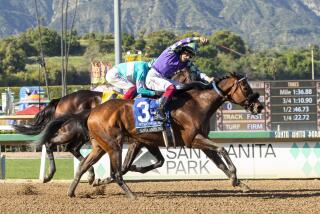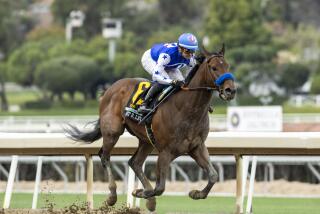The day Swaps met his match

The focus on Art Sherman, with stories that seek to flavor who he is and how he thinks as he prepares his horse for a run at the Triple Crown, zeros in on May 7, 1955.
A better date might be Aug. 31 of that year.
In the oft-told story, Sherman was an 18-year-old exercise rider for the famed Swaps, who won the Kentucky Derby that May. In the lesser-known story, he was also the exercise rider for Swaps for the famous match race with Nashua.
On a rainy Thursday morning in the Belmont Park barns, as daylight arrived along with two reporters, the 77-year-old Sherman told the story.
“I was on the trip” from California to Chicago, Sherman said. “We were like three, four days [on the train]. We brought a couple of extra horses. We had like six. I had a sleeping bag and there were three horses on this side of me and three on the other. In the night, they’d dip in their water bucket and hit me. I looked worse than the horses when we got there. Jeez, what a trip.”
The race was scheduled for Washington Park. It was owned by Ben Lindheimer, whose daughter, Marje Everett, would eventually take over the operation and later move to California and run Hollywood Park.
Swaps had won the Kentucky Derby, but had not entered the Preakness or Belmont.
“I don’t think they had the money” for the entry fees, Sherman said.
Swaps was owned by Rex Ellsworth and bred on his farm in Ontario. When he won the Derby, he was only the second California-bred to do so, following Morvich in 1922. When Sherman’s California Chrome won the Derby this year, he was only the fourth Cal-bred, following Decidedly in 1962.
“They [the owners] had horses coming up and they were always short,” Sherman said. “Your paycheck was always late. I made $75 a month the first year, $150 the second and $250 the third.
“I was living high on the hog. If there wasn’t a lady feeding me at the Big W Drive In, I would have been in big trouble.”
Nashua, an Eastern horse, finished second to Swaps in the Derby and then won the Preakness and Belmont. The question then was as national as the sport: Which horse was better?
So came the inevitable, a $100,000 winner-take-all match race, although Sherman said he was certain Swaps’ owners were paid nicely, win or lose.
The event was a magical attraction. Not only were these among the best 3-year-olds of their era, but there was the East-versus-West dynamic. There were also two of the best jockeys ever. Bill Shoemaker, who went as Willie then, rode Swaps and Eddie Arcaro rode Nashua.
A crowd of 35,262 showed up. National reporters swarmed Chicago. Odds for Swaps were set at 3-10; for Nashua 6-5. For once, gambling took a back seat to the purity of competition. A total of $175,000 was bet on the race, less than all the other races that day at Washington Park, except the first race.
Unknown to most, and an element that has stuck with Sherman to this day, was that Swaps had a foot injury and wasn’t anywhere near his best.
“He shouldn’t have run the match race,” Sherman said Thursday.
He said Swaps had an inch-long hole and abscess on the frog of his foot that they filled with iodine and cotton and covered with a leather pouch to keep dirt out. The frog on a horse’s foot is a triangular-shaped area that serves as a shock absorber when he runs.
“To me, [running Swaps] was kind of unbelievably dumb,” Sherman said. “Swaps was too much horse for Nashua.… One had natural ability. The other, you kind of had to beat the crap out of him. I watched Arcaro work on him. He was cutting him under the belly, doing everything.”
Arcaro later said that he had found a soft path on the track about four widths from the rail. He said he put Swaps there by breaking first from the inside and pushing Swaps and Shoemaker out to that soft spot all the way around.
Sherman bristled at that.
“I just don’t believe that,” he said.
Nashua won by daylight and was voted horse of the year. Swaps raced no more that year, but healed up and won eight of 10 races in 1956, including six carrying 130 pounds. Nashua ran with 130 pounds twice that year and lost both races.
At the end of 1956, Swaps was named horse of the year.
All of which adds up to a nice story with sizable significance for horse racing, which is under attack by PETA and its hidden cameras and the New York Times and its anti-drug reporting, as well as suffering from the all-too-frequent horror of horses breaking down and being destroyed on the track.
Sherman, a man on the doorstep of giving his sport a positive and legendary moment in its history, saw Swaps run when he shouldn’t have, has never forgotten it, said he was devastated, and added:
“If my horse wasn’t 100%, I’d have no qualms about not running him. I’d never do that.
“Even the Belmont.”
More to Read
Get our high school sports newsletter
Prep Rally is devoted to the SoCal high school sports experience, bringing you scores, stories and a behind-the-scenes look at what makes prep sports so popular.
You may occasionally receive promotional content from the Los Angeles Times.







